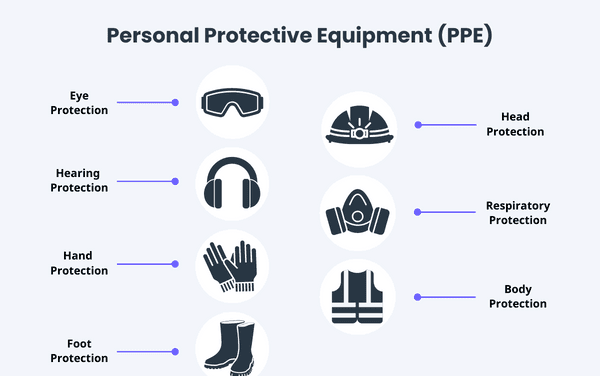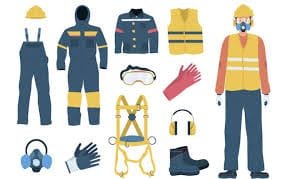Introduction to PPE
Personal Protective Equipment (PPE) is the backbone of workplace safety. From construction sites filled with heavy machinery to hospitals buzzing with healthcare professionals, PPE is the unsung hero that shields workers from injuries and illnesses.
Think of PPE as your personal shield—just like a knight wouldn’t go into battle without armor, workers shouldn’t step into hazardous environments without the right protective gear. The importance of PPE can’t be overstated—it saves lives, prevents accidents, and ensures employees go home safe at the end of the day.
Categories of PPE
PPE isn’t a “one-size-fits-all” solution. It comes in different categories, each addressing specific risks. These include:
- Head Protection – Helmets, bump caps
- Eye & Face Protection – Safety glasses, goggles, face shields
- Hearing Protection – Earplugs, earmuffs
- Respiratory Protection – Masks, respirators, SCBA
- Hand Protection – Gloves of different materials and purposes
- Body Protection – Lab coats, coveralls, flame-resistant clothing
- Foot Protection – Boots, safety shoes, chemical-resistant footwear
- Fall Protection – Harnesses, lifelines, safety nets
- Skin Protection – Sunscreens, creams, sleeves
- Specialized PPE – Electrical, radiation, and medical PPE
Head Protection
Head injuries are among the most dangerous workplace accidents. That’s why helmets and hard hats are mandatory in industries like construction, mining, and oil rigs.
- Helmets and Hard Hats: Designed to absorb impact from falling objects and protect against electric shocks.
- Bump Caps: Lightweight protection against minor bumps and scrapes, often used in warehouses.
When to use: Always wear head protection when working at heights or in areas with a risk of falling objects.
Eye and Face Protection
Your eyes are delicate—one spark, chemical splash, or speck of dust can cause lasting damage.
- Safety Glasses: Provide a basic shield against dust and debris.
- Goggles: Seal tightly around eyes, blocking chemicals and liquids.
- Face Shields: Protect against flying debris, sparks, and chemical splashes—usually paired with goggles.
- Welding Helmets: Specialized helmets for welders, offering protection from radiation and sparks.
Hearing Protection
Prolonged exposure to loud noises doesn’t just irritate; it leads to permanent hearing loss.
- Earplugs: Compact and affordable, they reduce noise exposure effectively.
- Earmuffs: Cover the ears completely, ideal for environments with continuous loud noise.
- Noise-Cancelling Headsets: Advanced protection against industrial noise while allowing communication.
Respiratory Protection
Breathing in harmful particles or gases can lead to severe health problems.
- Dust Masks: Filter non-toxic dust, pollen, and other small particles.
- Respirators: Half-face or full-face versions protect against chemicals, fumes, and toxic substances.
- SCBA (Self-Contained Breathing Apparatus): Commonly used by firefighters, it supplies clean air in toxic environments.
Hand Protection
Hands are constantly exposed to risks like cuts, burns, and chemical exposure.
- Disposable Gloves: Used in healthcare, labs, and food industries.
- Cut-resistant Gloves: Made of Kevlar or other strong materials to prevent cuts.
- Heat-resistant Gloves: Protect against burns in industries like metalworking.
- Chemical-resistant Gloves: Designed with materials like nitrile or neoprene to withstand harsh chemicals.
Body Protection
Your body needs full coverage when dealing with hazards.
- Coveralls and Lab Coats: Protect from spills, dust, and splashes.
- Aprons: Useful in kitchens, labs, and medical fields.
- Flame-resistant Clothing: Worn by welders and firefighters.
- High-Visibility Vests: Enhance worker visibility in traffic-heavy or low-light environments.
Foot Protection
Feet are at risk of crushing, punctures, and chemical spills.
- Safety Boots: Reinforced for durability and protection.
- Steel-toe Shoes: Extra protection against falling objects.
- Anti-Slip Footwear: Essential for Wet or Oily Workplaces.
- Chemical-resistant Footwear: Used in labs and chemical industries.
Fall Protection
Falls are one of the leading causes of workplace deaths.
- Safety Harnesses: Prevent free falls when working at heights.
- Lanyards and Lifelines: Provide mobility while ensuring safety.
- Guardrails and Safety Nets: Offer collective fall protection for groups of workers.
Skin Protection
Often overlooked, but crucial for long-term health.
- Sunscreen: Protects outdoor workers from UV radiation.
- Protective Sleeves: Shield arms from cuts and burns.
- Barrier Creams: Prevent harmful substances from penetrating the skin.
Specialized PPE
Some workplaces require PPE designed for unique hazards.
- Electrical Protection: Insulated gloves and arc flash suits prevent shocks.
- Radiation Protection: Lead aprons and shields safeguard healthcare workers.
- Medical PPE: Masks, gowns, gloves, and face shields reduce infection risks.
PPE in Different Industries
Different industries require different sets of PPE:
- Healthcare: Gloves, masks, gowns, and face shields.
- Construction: Helmets, boots, vests, and harnesses.
- Manufacturing: Gloves, respirators, and ear protection.
- Mining and Oil & Gas: Respiratory PPE, helmets, harnesses.
- Food Processing: Aprons, gloves, hairnets, and slip-resistant shoes.
Proper Use and Limitations of PPE
PPE is effective only if worn correctly. Proper fitting, maintenance, and employee training are essential. However, PPE should not replace safe work practices—it’s the last line of defense after eliminating hazards through engineering and administrative controls.
Future of PPE
PPE is evolving with technology. The future includes:
- Smart PPE: Helmets and vests with sensors that detect fatigue or hazards.
- Eco-friendly PPE: Made from sustainable and recyclable materials.
- Improved Comfort: Designs focusing on ergonomics and breathability for long-term use.
Conclusion
PPE is the frontline defense for workers across industries. Understanding the types of PPE and their applications ensures better safety, compliance, and confidence at work. At the end of the day, PPE isn’t just about rules—it’s about protecting lives.
FAQs
1. What is the most commonly used PPE?
Gloves and safety glasses are the most widely used.
2. Can PPE be reused?
Some PPE, like helmets, can be reused, but disposable items like gloves should not.
3. Who is responsible for providing PPE?
Employers are legally obligated to supply PPE in most industries.
4. How do I know which PPE to use?
Conduct a risk assessment to determine the hazards present.
5. Is PPE required by law?
Yes, occupational safety laws mandate appropriate PPE in high-risk workplaces.


0 Comments